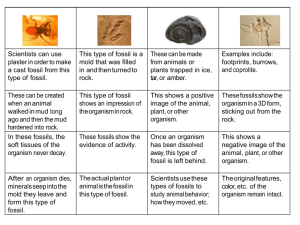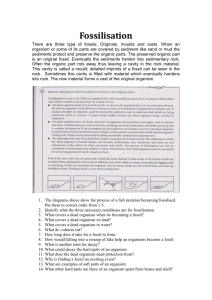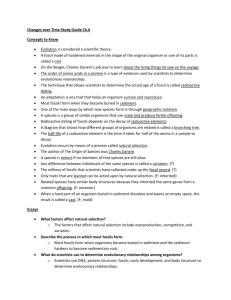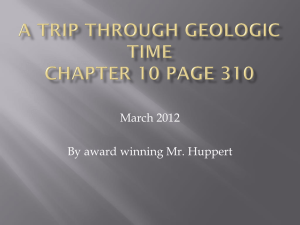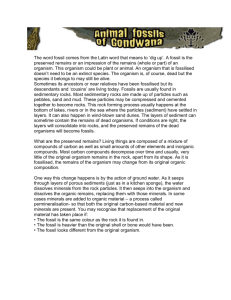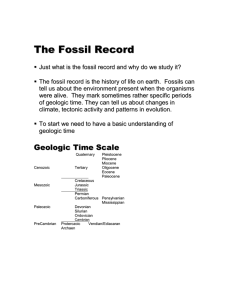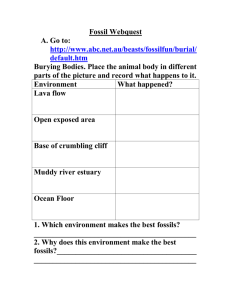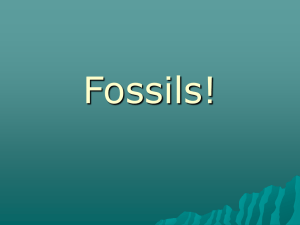What is a Fossil? - Ms. Keener
advertisement
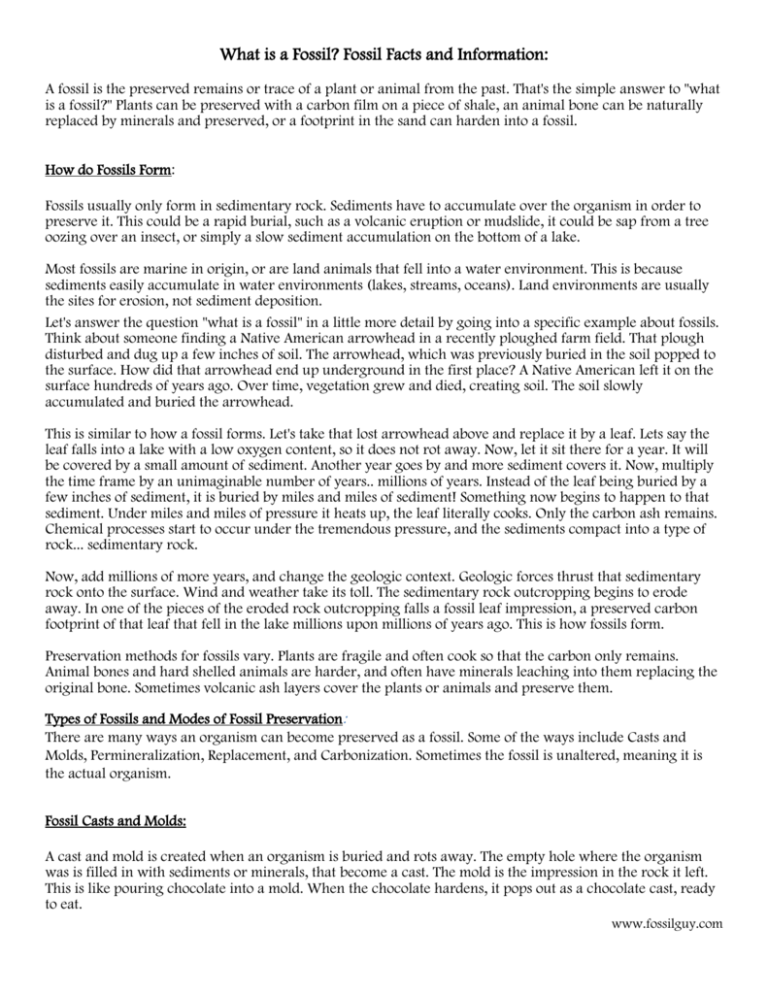
What is a Fossil? Fossil Facts and Information: A fossil is the preserved remains or trace of a plant or animal from the past. That's the simple answer to "what is a fossil?" Plants can be preserved with a carbon film on a piece of shale, an animal bone can be naturally replaced by minerals and preserved, or a footprint in the sand can harden into a fossil. How do Fossils Form: Fossils usually only form in sedimentary rock. Sediments have to accumulate over the organism in order to preserve it. This could be a rapid burial, such as a volcanic eruption or mudslide, it could be sap from a tree oozing over an insect, or simply a slow sediment accumulation on the bottom of a lake. Most fossils are marine in origin, or are land animals that fell into a water environment. This is because sediments easily accumulate in water environments (lakes, streams, oceans). Land environments are usually the sites for erosion, not sediment deposition. Let's answer the question "what is a fossil" in a little more detail by going into a specific example about fossils. Think about someone finding a Native American arrowhead in a recently ploughed farm field. That plough disturbed and dug up a few inches of soil. The arrowhead, which was previously buried in the soil popped to the surface. How did that arrowhead end up underground in the first place? A Native American left it on the surface hundreds of years ago. Over time, vegetation grew and died, creating soil. The soil slowly accumulated and buried the arrowhead. This is similar to how a fossil forms. Let's take that lost arrowhead above and replace it by a leaf. Lets say the leaf falls into a lake with a low oxygen content, so it does not rot away. Now, let it sit there for a year. It will be covered by a small amount of sediment. Another year goes by and more sediment covers it. Now, multiply the time frame by an unimaginable number of years.. millions of years. Instead of the leaf being buried by a few inches of sediment, it is buried by miles and miles of sediment! Something now begins to happen to that sediment. Under miles and miles of pressure it heats up, the leaf literally cooks. Only the carbon ash remains. Chemical processes start to occur under the tremendous pressure, and the sediments compact into a type of rock... sedimentary rock. Now, add millions of more years, and change the geologic context. Geologic forces thrust that sedimentary rock onto the surface. Wind and weather take its toll. The sedimentary rock outcropping begins to erode away. In one of the pieces of the eroded rock outcropping falls a fossil leaf impression, a preserved carbon footprint of that leaf that fell in the lake millions upon millions of years ago. This is how fossils form. Preservation methods for fossils vary. Plants are fragile and often cook so that the carbon only remains. Animal bones and hard shelled animals are harder, and often have minerals leaching into them replacing the original bone. Sometimes volcanic ash layers cover the plants or animals and preserve them. Types of Fossils and Modes of Fossil Preservation: There are many ways an organism can become preserved as a fossil. Some of the ways include Casts and Molds, Permineralization, Replacement, and Carbonization. Sometimes the fossil is unaltered, meaning it is the actual organism. Fossil Casts and Molds: A cast and mold is created when an organism is buried and rots away. The empty hole where the organism was is filled in with sediments or minerals, that become a cast. The mold is the impression in the rock it left. This is like pouring chocolate into a mold. When the chocolate hardens, it pops out as a chocolate cast, ready to eat. www.fossilguy.com Examples of fossil casts and molds include: Fossil shells are often casts, and shell impressions on rock are often molds. A fossilized footprint is a mold. Plant fossils and trilobites are often found as casts and molds. Permineralization and Replacement: Permineralization is when the organism is buried in the ground, minerals from ground water seep into the organism and slowly fill in the pores in the animal, adding rock forming minerals to the hard parts of the animal. Replacement is similar, in that minerals seep into the organism. However, the minerals replace the original organic material, as the organic material rots away. In the end, the organism is replaced by minerals. Many fossils are preserved these ways, from Fossil Sharks Teeth, to Trilobites, to Bone. Carbonization: Carbonization is the process where only the residual carbon of the organism remains. In nature this usually happens over time when the organism is subject to heat and pressure. A very common example of carbonization are fossil plants, where only a thin carbon layer is left on a piece of shale. In the Carboniferous time period, fast fern forests created miles of carbon, which we mine today as coal. Another, more recent example is the fossilized feathers found on dinosaurs in China. These are left as carbon imprints in the shale around the mineralized dinosaur bones. It's important to note that most fossils are preserved by more than one mode. For example, the fossil leaves are carbonized, but also leave a cast and mold. Fossil ammonites are casts, however, they also are mineralized. Fossil trilobites are often found as casts and molds, but their exoskeletons are mineralized (usually replaced by calcite). Unaltered remains: An organism is considered unaltered if there is no change in the original composition of the organism. A famous example of this is found at the La Brae Tar Pits in Los Angeles. Here, Ice Age animals became trapped and sunk into the tar pits. The soft tissues rotted away, but the original bones still remain. Original bones from Saber Toothed Cats, Giant Ground Sloths, Short Faced Cave Bears, Dire Wolves, and many more strange creatures are all unaltered. Another example includes insects and small animals trapped in Amber. The sap from a once living tree entombed the animals. This sap eventually hardened, and the original animals are preseved inside the amber. Trace Fossils: A trace fossil is a fossil not of an organism, but instead a fossil of an organisms activity. For example, a trace fossil can be a mold or cast of a footprint, or a cast of a fossil burrow. Animal borrows that have been filled in by sediment are very common in many sedimentary rock outcroppings. www.fossilguy.com
